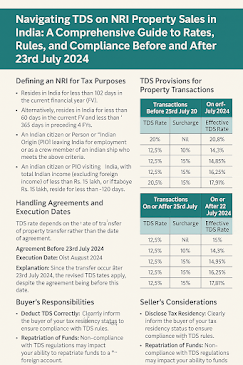When a Non-Resident Indian (NRI) sells immovable property in India, the buyer is obligated to deduct tax at source (TDS) under Section 195 of the Income Tax Act, 1961. The correct application of this provision is crucial for ensuring tax compliance, avoiding penalties, and facilitating the seller’s ability to repatriate funds abroad. This guide provides a detailed legal and practical analysis of the applicable TDS rates, the impact of changes effective 23rd July 2024, and compliance steps for both buyers and sellers.
1. Who is an NRI for Tax Purposes
Under Indian tax law, an individual is treated as a Non-Resident Indian (NRI) for a financial year if they meet any of the following:
-
Stayed in India less than 182 days during the relevant FY,
-
OR stayed less than 60 days in the FY and less than 365 days in the preceding 4 FYs.
Additional thresholds apply for Indian citizens or Persons of Indian Origin (PIOs) visiting India:
| Indian Income (excluding foreign) | Residential Status Threshold |
|---|---|
| Less than ₹15 lakh | Resident if stay ≥ 182 days |
| ₹15 lakh or more | Resident if stay ≥ 120 days |
2. TDS on Property Sales – Section 195 Framework
2.1 📅 Transactions Before 23rd July 2024
For properties held for more than 2 years (classified as Long-Term Capital Assets), the base TDS rate is 20%. Surcharge and cess are added based on sale value.
| Sale Consideration | Base Rate | Surcharge | Effective TDS Rate (Incl. 4% Cess) |
|---|---|---|---|
| Less than ₹50 lakhs | 20% | Nil | 20.8% |
| ₹50 lakhs – ₹1 crore | 20% | 10% | 22.88% |
| ₹1 crore – ₹2 crore | 20% | 15% | 23.92% |
| ₹2 crore – ₹5 crore | 20% | 15% (capped) | 23.92% |
| Above ₹5 crore | 20% | 15% (capped) | 23.92% |
Example:
Sale Price: ₹1.5 crore
-
LTCG TDS @ 20% = ₹30,00,000
-
Surcharge @ 15% = ₹4,50,000
-
Subtotal = ₹34,50,000
-
Cess @ 4% = ₹1,38,000
-
Total TDS = ₹35,88,000
-
Net to seller = ₹1,14,12,000
2.2 📅 Transactions On or After 23rd July 2024
As per CBDT Notification dated 23.07.2024, the base TDS rate on LTCG for NRIs is reduced to 12.5%. The surcharge cap of 15% remains.
| Sale Consideration | Base Rate | Surcharge | Effective TDS Rate (Incl. 4% Cess) |
|---|---|---|---|
| Less than ₹50 lakhs | 12.5% | Nil | 13% |
| ₹50 lakhs – ₹1 crore | 12.5% | 10% | 14.3% |
| ₹1 crore – ₹2 crore | 12.5% | 15% | 14.95% |
| ₹2 crore – ₹5 crore | 12.5% | 15% (capped) | 14.95% |
| Above ₹5 crore | 12.5% | 15% (capped) | 14.95% |
Example:
Sale Price: ₹1.5 crore
-
LTCG TDS @ 12.5% = ₹18,75,000
-
Surcharge @ 15% = ₹2,81,250
-
Subtotal = ₹21,56,250
-
Cess @ 4% = ₹86,250
-
Total TDS = ₹22,42,500
-
Net to seller = ₹1,27,57,500
3. Importance of Execution Date
The date of execution (transfer) determines the applicable TDS rate—not the agreement date.
Scenario:
-
Agreement Date: 1st June 2024
-
Execution Date (Sale Deed): 1st August 2024
🔍 Since execution is after 23rd July 2024, the reduced rate of 12.5% (with capped surcharge) will apply.
4. Buyer’s Legal Responsibilities
Key Compliance Steps:
-
Obtain TAN – A Tax Deduction Account Number is mandatory under Section 195.
-
Deduct Correct TDS – As per execution date and value brackets.
-
Deposit TDS – By the 7th of the next month via e-challan 281.
-
File Form 27Q – Quarterly TDS return for NRI payments.
-
Issue Form 16A – TDS certificate to the seller.
⚠️ Consequences of Non-Compliance:
| Default | Penalty / Interest |
|---|---|
| TDS not deducted | Equal to shortfall u/s 271C |
| TDS deducted but not deposited | Interest u/s 201(1A) @ 1–1.5% per month |
| Incorrect rate used | Entire shortfall becomes buyer’s liability |
Example:
TDS deducted @ 1% (wrong) instead of 20.8% on ₹1.5 Cr →
• TDS shortfall ≈ ₹34,38,000
• Buyer liable for penalty and interest on this amount
5. Seller’s Legal and Strategic Considerations
What NRIs Must Ensure:
-
Declare NRI Status: Misclassification can lead to wrong TDS deduction.
-
Plan Repatriation: Without valid TDS, Form 15CA/15CB issues may block repatriation.
-
Apply for Lower/Nil TDS Certificate: Via Form 13, especially if actual capital gain is much lower than sale consideration.
-
File ITR in India: Claim refund, if TDS exceeds tax payable.
⚠️ Without a Lower Deduction Certificate, TDS is deducted on gross sale value, not net capital gain.
Summary Table of Key Rates
| Period | Base TDS | Max Surcharge | Effective Max Rate (incl. 4% cess) |
|---|---|---|---|
| Before 23 July 2024 | 20% | 15% | 23.92% |
| On/After 23 July 2024 | 12.5% | 15% | 14.95% |
Final Advice to NRIs and Buyers
✔️ Buyers must exercise due diligence: get TAN, deduct TDS at the correct rate, file timely returns, and issue certificates.
✔️ NRIs must plan their transactions smartly—seek professional advice, obtain lower deduction certificates, and file Indian tax returns to claim refunds or carry forward losses.

